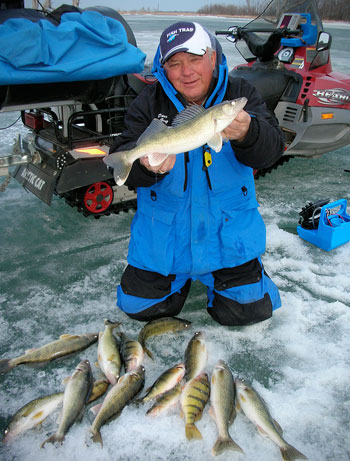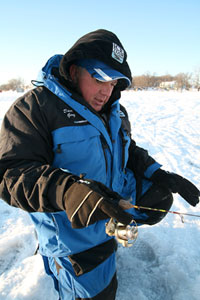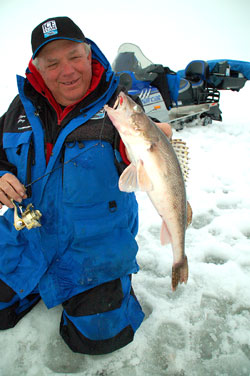During daylight hours, ice fishing is a very different pursuit than it is during the prime times of dawn and dusk. To generalize, rather than moving in active pursuit of food, most daytime fish are sitting “fat, dumb and happy” in the words of Dave Genz.
 This means that, in order to make consistent catches through the ice on most days, you have to track down the hiding spots of scattered fish, then tempt them into biting when they aren’t really in the mood. You have to remain on the move, because there are fewer ‘biters’ than there will be at prime time.
This means that, in order to make consistent catches through the ice on most days, you have to track down the hiding spots of scattered fish, then tempt them into biting when they aren’t really in the mood. You have to remain on the move, because there are fewer ‘biters’ than there will be at prime time.
To make matters more challenging, even the small percentage of fish that can be tempted have to be presented with a truly realistic-looking fake food item or they will probably snub your offering. In other words, if your presentation is sloppy–even if it might get bit at sunrise or sunset–you won’t catch much.
The unforgiving hours of daylight demand your best efforts, but if you pay attention to detail and follow the proven Winter Fishing System, you can piece together a good catch.
“That’s what daytime ice fishing is,” begins Dave Genz, the godfather of modern ice fishing and a member of the National Fresh Water Fishing Hall of Fame. “You piece together a good catch a few at a time, with lots of moving and drilling holes between bites.”
For today, we focus on walleyes. Next time, we’ll talk panfish.
Understanding Those Amazing Eyes
It’s important to know that walleyes have ‘eye’ in their name for a reason. Their eyes contain super powers, at least in the realm of fish.
Positioned behind the walleye’s retina is a reflective membrane called the tapetum lucidum. This substance is exceptionally white, its purpose to gather, and reflect, light.
When light enters a walleye’s eye, it is picked up by the retina, but also bounced around by the reflective tapetum, back to the retina numerous times. This essentially ‘multiplies’ light, but only for the walleye, not for its hapless prey—especially not the closely-related yellow perch. This helps explain why walleyes feed seriously when (and where) light is low.
Walleye ‘Daytime Prime Time’
When it comes to walleyes, prime time is anytime–and anywhere–light is low, especially if it’s changing rapidly on the way to or from low. So here’s the first secret to consistently catching daytime walleyes: go where the light is low–even under the glare of sunshine!
Water clarity is the thing. Simply put, in stained or dirty-water lakes, high sky sunshine can be the time for walleyes.
“If you want to catch walleyes during the day,” says Genz, “fish dirty water. You can catch ‘em in clear water, but your chances are better if the lake is on the dirty side. At least that’s the case on a bright day.”
The big-picture puzzle comes together in Dave’s last statement: in clear water, prime time can be anytime, if clouds roll in and shut out the sunshine.
“You have to pay attention to what the weather is doing,” says Dave. “Your plan might be to fish bluegills or perch in the middle of the day, then switch over to walleyes when the sun gets low in the sky. The day starts out sunny, but then clouds roll in and it becomes a dark day. What happens is that prime time starts early on days like that.”
As Dave says, it’s important to notice shifting light levels, and switch over to walleye mode as soon as things begin to darken down.
Finding Daytime Walleyes
Under normal conditions, to score on walleyes from mid-morning through mid-afternoon, the percentage play is to fish a lake with stained or dirty water. Finding such a lake is easy; most lake maps have information about water clarity. Just keep in mind that most lakes are at their clearest after ice forms and sediments settle. Also realize that some lakes go through a ‘cloudy period’ after weeds die off, and this can cause an otherwise clear lake to ‘get dirtier.’
 “When you drill your first holes,” says Genz, “see what the water clarity is at the moment. That means, the condition of the water, the amount of snow and ice, and the lighting conditions. I love using my Vexilar underwater camera for this.”
“When you drill your first holes,” says Genz, “see what the water clarity is at the moment. That means, the condition of the water, the amount of snow and ice, and the lighting conditions. I love using my Vexilar underwater camera for this.”
In clear (or semi-clear) water, the biggest key, typically, is looking for catchable fish where light levels approximate prime time—which means deeper water, or the shade of cover like weeds or wood.
Genz has long theorized that prey often choose to position at depth levels featuring just enough light to allow them to function, but where predators (like walleyes) have a harder time seeing them. One shortcut that often leads to daytime walleyes in clear-water environments: Look at the base of dropoffs, where the harder surface of the drop gives way to softer bottom.
This is the sticky-bottom area that Genz was the first to talk about, and is often the most under-fished zone.
“Find the sticky bottom area right where the dropoff ends,” he says. “That’s where you find bloodworms, mayfly larvae, other insects. There’s life there, and that attracts predator fish, walleyes included.”
Weeds, particularly when they’re still standing and green, hold walleyes year-around, ice season included. Even though the rapidly-changing light levels of evening and early morning are usually the best times in clear water environments, daytime ‘eyes can be caught in the weeds, especially along the deeper edges and openings in lush patches.
Wood (timber and brush) is always good, too, and can be the only shallow cover in some systems, particularly reservoirs.
Presentation for Daytime Walleyes
In crystal clear water under high barometric pressure, smaller baits can shine. At prime times, walleyes actively seek food, and bigger can be the trigger.
 Treat every outing as an experiment. Don’t live and die by the rules. Start with what makes sense, but give the fish different looks. They’ll ‘tell you’ what they want by their response.
Treat every outing as an experiment. Don’t live and die by the rules. Start with what makes sense, but give the fish different looks. They’ll ‘tell you’ what they want by their response.
It’s crucial to carry a variety of lures, plastics, and live baits. Genz has developed and continues to help refine ice lures for Lindy. The development of Techni-Glo finishes, and the Tazer to charge them, helps walleyes see your bait better. Even walleyes can use a hand in the vision department where light is low.
Flyers are aggressive, horizontal-shooting swim baits that come in many sizes. When allowed to do their thing on a slack line after you pump them, they swim like a fish, erratically, gliding and head-thumping side to side.
The Rattl’n Flyer Spoon is a great walleye bait, but it must be fished hard. Shake it to get those rattles talking. Let it flutter on the fall. Keep it moving.
The Lindy Darter is a subtle but extremely effective walleye bait that you fish without live bait. And the Slick Jig is a horizontal ice jig in the right sizes for walleyes, that can be tipped with live bait or Techni-Glo plastics.
The Genz Bug, with its signature kicking motion due to the 45-degree-angled hook, has become another of Dave’s go-to daytime walleye presentations. It fishes well with plastic tails or live baits. “It has a different type of kicking motion,” says Genz. “I think it resembles a fry swimming in the water. It really triggers fish.” A huge plus: when packed with maggots, the Genz Bug falls slowly, like a parachute, rarely spinning. In ice fishing, spinning is not good.
Many of you would not consider the Fat Boy or Genz Worm potential walleye trickers, but Dave packs the larger sizes with maggots or waxies and turns daytime walleyes into ready biters. A little-known package gaining in popularity: mate these jigs with a contrasting Techni-Glo plastic tail. You can ‘pound’ it to get the tail and head kicking, or ‘swim’ it smoothly. Again, show the walleyes alternatives and they’ll tell you when you have it right—for the moment.
Keep Moving
When it comes to daytime ice fishing advice, Genz always cautions against letting a big fish get in the way of remaining on the move.
“Be happy when you catch a nice fish,” he says. “But don’t fall in love with that hole. Hang in there for a while. But if you don’t catch another one within about 5 or 10 minutes, go to the next hole.”
Note: Dave Genz, known as Mr. Ice Fishing, was the primary driver of the modern ice fishing revolution. He has been enshrined in the National Fresh Water Fishing Hall of Fame and Minnesota Fishing Hall of Fame for his contributions to the sport. For more fishing tips, go to www.davegenz.com.










